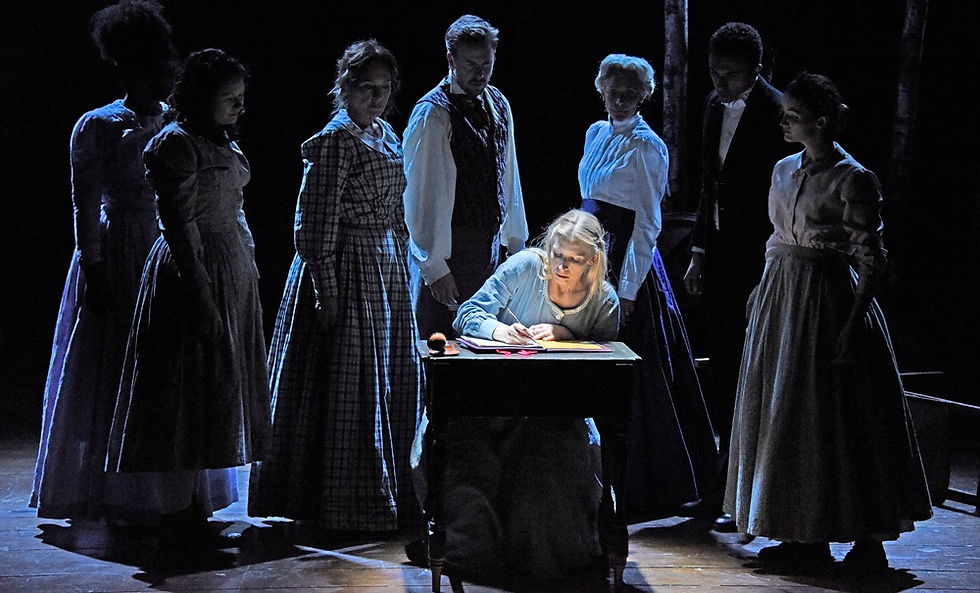The Legend of Ned Ludd | Liverpool Everyman
- Rosie Davis (she/her)

- Apr 25, 2024
- 3 min read
The Legend of Ned Ludd contains an impressive multitude of stories: it is a portal to the past, a snapshot of the present, and a foreshadowing of the future. Fresh and original in its form, its pieces slowly whir and click together effortlessly, forming a deeply affecting interrogation of technological advancement and capitalism through the ages.
The play is made up of fragmented scenes, most randomly selected by the omnipresent ‘machine’ that dominates the stage. Places and dates flicker on screen before the machine decides where and when we will travel to, and the actors follow its command. The result is an eclectic mixture of stories and characters, only occasionally converging in the moments that are fixed (there are a total of 256 possible versions of the play, but some of the scenes will always remain the same). The stories examine workmanship, capitalism, technology and humanity.
Formally, Joe Ward Munrow’s concept (of the randomly generated order) is a fascinating one, intertwining effectively with the themes that we return to throughout. It feels fresh, exciting, and original, and the handling of each individual scene is equally impressive. However, as with most examples of fragmented art (e.g. a collection of short stories), it can be more noticeable if one scene or one moment is stronger than another. This is hardly ever an issue here – but, it did seem to be the case that the more subtle, naturalistic scenes were much more emotionally potent than a more poetic, abstract scene that took place after the interval (in the version of the play I saw, at least). This specific scene prioritised movement and poetic language over narrative and personal stories, and although it was still very well written, it didn’t land as well as the rest of the scenes in the play.

The subtlety of the intersecting, overlapping stories continued into the actors’ performances too. Reuben Johnson, Menyee Lai and Shaun Mason are the three performers apparently at the mercy of the machine, yet they all still showcase a commanding and engaging presence. They handled both the intimate and dramatic moments well, and moved smoothly between place and time. A few scenes were especially tender; in one, an apprentice (Mason) is taught the difference (by Lai) between a wall painted by a painter-decorator and one painted by someone completing the job as a chore. This scene works beautifully, and is emblematic of the actors’ grip of both minimalism and emotion.
Perhaps, the role of their puppeteer - the machine itself - could have been more effective if it had a clearer demarcation of the randomness of its selection. The plastic balls that moved through the machine and landed in two glass boxes on stage, for example, seemed to be a purely aesthetic feature, and had no bearing on the machine’s actual role. It would have been nice to see a greater level of interaction here, such as if the balls had numbers that corresponded to numbers on the cardboard boxes (the boxes containing the costumes and props for each scene). Then we might have a had a greater indication of the precarity and inconstancy of the pay’s structure, a feeling that mirrors its content.
Aside from this, though, the set and props (by Hazel Low) are a perfect portal, allowing us to move through time. The way the space transforms depending on the scene adds to its multitudinous quality, and the factory-esque backdrop is perfect: we are rooted in a setting of work and labour, a cyclical place of repetition without breaks (with the patterns of the machine, and the constant unpacking and packing of the boxes). It is a liminal, lonely space.
The Legend of Ned Ludd captures and maintains a mythic feel, as it moves through history; it is a portal, a legend, a vein of injustice and social unrest, almost bursting. It is completely bound up in humanity. Truly the 'story of stories’, it is a play that is very apt for our time. The Legend of Ned Ludd is playing at the Everyman theatre, in Liverpool, until the 11th May. For more information and tickets, click here.
⭐️⭐️⭐️⭐️
Gifted tickets in return for an honest review | photography by Marc Brenner







Comments